It’s cabbage fermentation time. Every spring around the time of Saint Patrick’s day, I start looking for deals on cabbage at my local grocer. This year I had a plan to buy just a few heads of cabbage and ferment a small half gallon batch of sauerkraut. Apparently however, the cabbage crop was abundant this year as I was able to pick up a case for $0.17/pound.

What is Fermentation?
Food fermentation is the anaerobic process of using using yeast or bacteria to convert carbohydrates and sugars into alcohol or organic acids. Humans have understood food fermentation as a preservation process for millennia.
With modern refrigeration and food preservation techniques, food fermentation has become mostly an artisanal hobby no longer required for survival.
The Art of Fermentation by Sandor Katz, is an excellent resource for DIY kitchen witches (beginners & experts).
When it comes to food, I’m an experimenter and adventurist. I love to learn a new process or recipe and then explore new flavor possibilities. Not to say these are undiscovered flavors or recipes, just that they are new to me.
The case of cabbage I purchased was approximately 45 lbs, and averaging about 2.5 pounds per head. Chopped and shredded, I packed 3 gallons in 6 small batches. The cabbage hearts and outer leaves were divided between the chicken scrap bucket and the compost bucket.
KrautChi Basics
Krautchi is a term for a hybrid of sauerkraut and kimchi coined by Sandor Katz in his book The Art of Fermentation. The process for making sauerkraut and kimchi is the same. For traditional versions of these ferments, the veggies differ just a bit. I of course am anything but a traditionalist, so krautchi appeals to me.
For this round of fermentation, my ingredients list includes green cabbage, white onion, fresh garlic, serrano peppers, sea salt, and fresh spicy oregano from the greenhouse.
Keep in mind when starting a fermentation, that there will always be flavor variations in your produce, due to varying growing conditions. For instance, the cabbage I bought for this round taste sweeter than I usually get. The garlic head I cracked open was really spicy, and the white onion is pretty mild. These factors will affect the final flavor of the finished krautchi.
I use the dry salting technique as described in The Art of Fermentation. I chop, shred and slice my ingredients by hand, though there is no reason you can’t use a food processor. The idea is to create more surface area for the lacto-bacteria to perform their magick.
Some people prefer a fine shred sauerkraut similar to most commercial sauerkraut. Over the years, I find that different chop styles, can result in different textures. I sometimes chop my veggies into 1/2 inch squares. This provides better surface area for fermentation, but helps the cabbage remain a crisper through the process for a crunchier kraut. You can use whole leaves or veggies also, but a brining technique is recommended in that instance. I encourage you to experiment and find what you like.
Most any type of salt will work for vegetable fermentation, Many recipes will warn not to use iodized salt, however it will work. I prefer sea salt which often offers trace minerals and nutrients that become bio available during the fermentation process.
Small Batch Fermentation
I generally prefer to make several small batches of ferment when I have a larger amount of produce to process. The primary reason is it allows flexibility with flavor profiles. Currently I have four half gallon and two quart size batches bubbling on the counter. Smaller batches offer more canvas for varying flavors, and if something does go wrong, the whole thing doesn’t go bad.
- Batch 1: Spicy Garlic Sauerkraut – 1 Quart Fine Shred – Cabbage, Garlic, Onion, and Sea Salt
- Batch 2: Plain Cabbage Sauerkraut – 1/2 Gallon Sliced- Cabbage, Sea Salt, Garlic
- Batch 3: FireKraut – 1/2 Gallon Medium Chopped – Cabbage, Serrano Peppers, Onion, Garlic, Sea Salt
- Batch 4: Sleeping Dragon? * – 1/2 Gallon Medium Chopped – Cabbage, Serrano Peppers, Garlic, Sea Salt
- Batch 5: Oniony Sauerkraut – 1/2 Gallon Chopped – Cabbage, Onion, Sea Salt
- Batch 6: Curtido – 1 Quart Sliced – Cabbage, Onion, Serrano Peppers, Garlic, Spicy Oregano, Sea Salt
* When I chopped the Sleeping Dragon? batch, I had enough initially to fill 2/3 of the 1/2 gallon jar. I chopped and salted plain cabbage to pack in the 1/3 of the jar. It will be interesting to see if and how this layering affects the final flavor profile of this batch.

Airlocks
An airlock will make life easier while fermenting. I made my own airlock lids, but you can purchase them here. There are different styles available, however I use these airlocks for my mead and beer brewing, so I just needed to cut some holes in mason jar lids.
Wait and Sample
Now the kraut is packed in jars. The airlocks are in place. I’ve created an ideal environment for the lacto bacteria naturally present in the vegetables. Now I wait for them to work their magick. I’ll sample the jars every few days until the flavor profile is to my liking.
The time required for a fermentation to run varies with a number of factors, including room temperature, amount of salt used, and personal preference. When the flavor profile of a ferment is to your liking, replace the airlock lid with a regular mason jar lid and put the jar in the refrigerator. Your probiotic krautchi will last for months in the fridge, though you will have to open it occasionally to release additional gas buildup. Also over time, your ferment will soften and eventually turn to mush as enzymes break down the pectin in the cabbage..
Benefits of Food Fermentation
For thousands of years, prior to modern refrigeration and canning, humans have used various microbes to do the work of preserving our food. These bacteria, yeast, and molds have evolved to help us preserve food, and can be beneficial to our microbiome health.
Further fermented foods will last much longer than raw vegetables alone. Once placed in refrigeration, fermented veggies will remain good for 6 month or more. Mine don’t usually last that long though.
Finally if you find a great deal on bulk veggies at your grocer or farmers market, or if your garden provides you an abundance, fermenting some of it will help make it last through the winter.

You can support the work of Heathen Planet and global reforestation by supporting our advertisers and shopping in the Heathen Planet Store. A portion of every sale is donated to OneTreePlanted to plant trees.

